英文版大学物理 第五章
大学物理第五章 习题解答
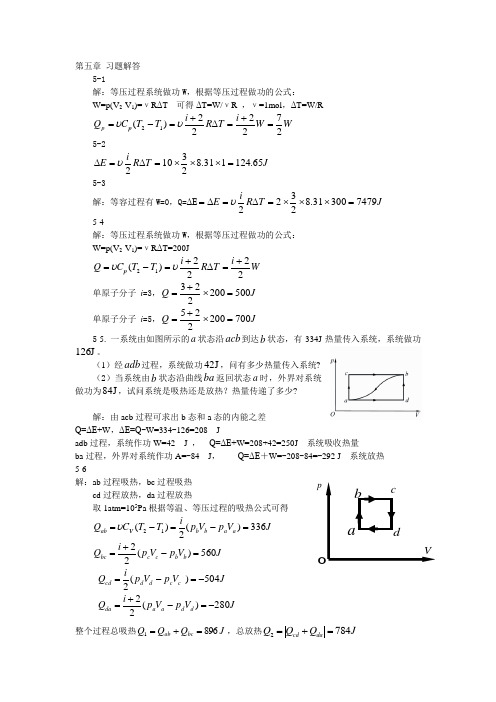
第五章 习题解答5-1解:等压过程系统做功W ,根据等压过程做功的公式:W=p(V 2-V 1)=νR ΔT 可得ΔT=W/νR ,ν=1mol ,ΔT=W/RW W i T R i T T C Q p 272222)(12=+=∆+=-=υυp 5-2 J T R i E 65.124131.823102=⨯⨯⨯=∆=∆υ5-3 解:等容过程有W=0,Q=ΔE J T R i E 747930031.82322=⨯⨯⨯=∆=∆=υ 5-4解:等压过程系统做功W ,根据等压过程做功的公式:W=p(V 2-V 1)=νR ΔT=200JW i T R i T T C Q 2222)(12+=∆+=-=υυp 单原子分子 i =3,J Q 500200223=⨯+= 单原子分子 i =5,J Q 700200225=⨯+= 5-5. 一系统由如图所示的a 状态沿acb 到达b 状态,有334J 热量传入系统,系统做功J 126。
(1)经adb 过程,系统做功J 42,问有多少热量传入系统?(2)当系统由b 状态沿曲线ba 返回状态a 时,外界对系统做功为J 84,试问系统是吸热还是放热?热量传递了多少?解:由acb 过程可求出b 态和a 态的内能之差Q=ΔE+W ,ΔE=Q -W=334-126=208 Jadb 过程,系统作功W=42 J , Q=ΔE+W=208+42=250J 系统吸收热量ba 过程,外界对系统作功A=-84 J , Q=ΔE +W=-208-84=-292 J 系统放热 5-6解:ab 过程吸热,bc 过程吸热 cd 过程放热,da 过程放热取1atm=105Pa 根据等温、等压过程的吸热公式可得J V p V p i T T C Q a a b b ab 336)(2)(12=-=-=V υ J V p V p i Q b b c c bc 560)(22=-+= J V p V p i Q c c d d cd 504)(2-=-= J V p V p i Q d d a a da 280)(22-=-+= 整个过程总吸热J Q Q Q bc ab 8961=+=,总放热J Q Q Q da cd 7842=+=p净功J Q Q W 11221=-=,效率%5.128967841112=-=-=Q Q η 5-7 卡诺热机的效率为%4028011112=-=-=T T T 卡η,可得高温热源温度7.4661=T K 如果%50'28011112=-=-=T T T 卡η,可得560'1=T K ,温度提高了3.93'11=-T T K 5-8 %251068.11026.1117712=⨯⨯-=-=Q Q η。
大学物理课件英文版课件,现代物理An Aperitif of Modern Physics
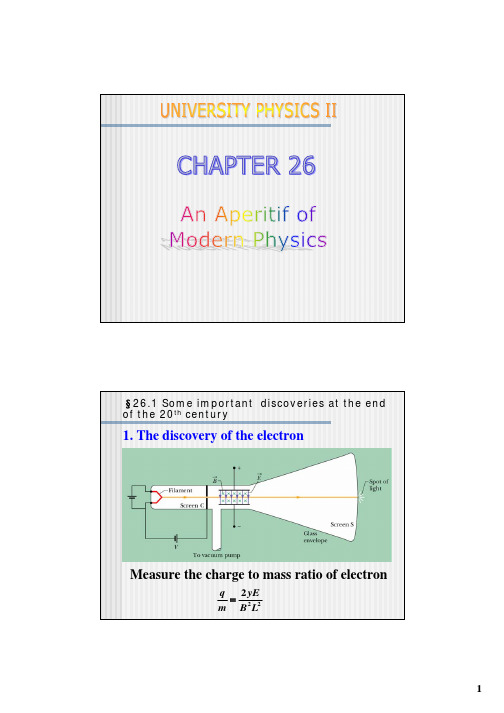
3
§26.1 Some important discoveries at the end of the 20th century
2. The discovery of X-rays
§26.1 Some important discoveries at the end of the 20th century
J. J. Thomson’s original tube
2
§26.1 Some important discoveries at the end of the 20th century
a. Measured the charge of the cathode rays; b. Make a static electric deflection of the cathode rays; c. Measured the charge to mass ratio of the cathode rays; d. Prove the universal existence of the electron. The charge to mass ratio of electron
Radioactivity occur naturally and have with us on the earth from the very beginning. Henri Becquerel discovered Uranium, Marie Curie discovered Polonium and Radium Ernest Rutherford found that the substances emit several distinct types of radiations. One is a penetrating radiation, dubbed α, that propagates through several centimeters in air and can even penetrate very thin metal foils. Another less penetrating radiation, dubbed β, is easily stopped by even a sheet of paper. Another type, called γ, was discovered in 1900 and is much more penetrating than even the α radiation.
英文版大学物理 第五章
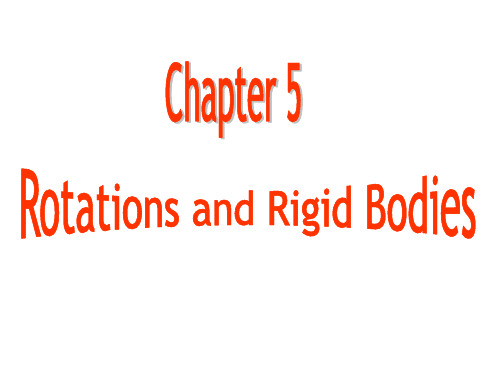
m r
2
i i
K 1 I 2 2
5-3. Calculating the Rotational Inertia If a rigid body consists of a few particles
If a rigid body consists of a great many of particles(it is continuous) Linear distribution: Surface distribution: Volume distribution:
The unit of angular acceleration is commonly the radian per second-squared (rad/s2) or the revolution per second-squared (rev/s2).
Are Angular Quantities Vectors?
(radian measure)
Equation of motion for a rotating body: = (t)
2. Angular Displacement When the body rotates about the rotation axis from 1 to 2, the body undergoes an angular displacement y 2 1 Reference At t2 line An angular displacement in the counterclockwise direction is positive, in the clockwise direction is negative. At t1 1 2 x 3. Angular Velocity O Rotation axis Average angular velocity The angular velocity is either 2 1 avg positive or negative, depending t2 t1 t on whether the body is rotating Angular velocity counterclockwise (positive) or d lim clockwise (negative). t 0 t dt
Feynman 费曼物理学讲义英文版 2至5章
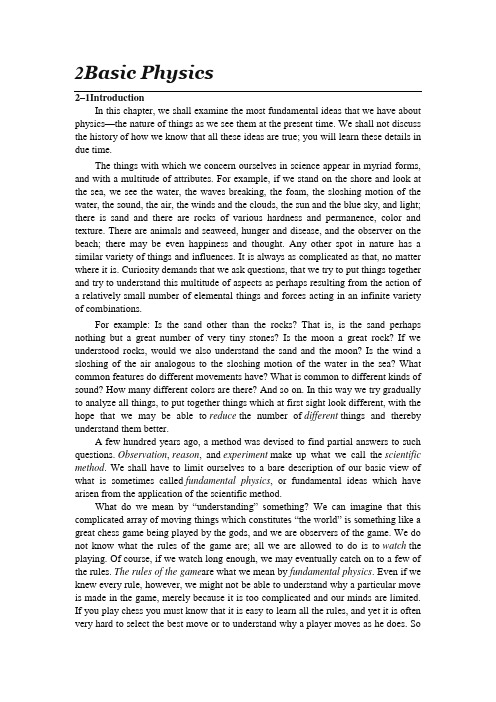
2Basic Physics2–1IntroductionIn this chapter, we shall examine the most fundamental ideas that we have about physics—the nature of things as we see them at the present time. We shall not discuss the history of how we know that all these ideas are true; you will learn these details in due time.The things with which we concern ourselves in science appear in myriad forms, and with a multitude of attributes. For example, if we stand on the shore and look at the sea, we see the water, the waves breaking, the foam, the sloshing motion of the water, the sound, the air, the winds and the clouds, the sun and the blue sky, and light; there is sand and there are rocks of various hardness and permanence, color and texture. There are animals and seaweed, hunger and disease, and the observer on the beach; there may be even happiness and thought. Any other spot in nature has a similar variety of things and influences. It is always as complicated as that, no matter where it is. Curiosity demands that we ask questions, that we try to put things together and try to understand this multitude of aspects as perhaps resulting from the action of a relatively small number of elemental things and forces acting in an infinite variety of combinations.For example: Is the sand other than the rocks? That is, is the sand perhaps nothing but a great number of very tiny stones? Is the moon a great rock? If we understood rocks, would we also understand the sand and the moon? Is the wind a sloshing of the air analogous to the sloshing motion of the water in the sea? What common features do different movements have? What is common to different kinds of sound? How many different colors are there? And so on. In this way we try gradually to analyze all things, to put together things which at first sight look different, with the hope that we may be able to reduce the number of different things and thereby understand them better.A few hundred years ago, a method was devised to find partial answers to such questions. Observation, reason, and experiment make up what we call the scientific method. We shall have to limit ourselves to a bare description of our basic view of what is sometimes called fundamental physics, or fundamental ideas which have arisen from the application of the scientific method.What do we mean by ―understanding‖ something? We can imagine that this complicated array of moving things which constitutes ―the world‖ is something like a great chess game being played by the gods, and we are observers of the game. We do not know what the rules of the game are; all we are allowed to do is to watch the playing. Of course, if we watch long enough, we may eventually catch on to a few of the rules. The rules of the game are what we mean by fundamental physics. Even if we knew every rule, however, we might not be able to understand why a particular move is made in the game, merely because it is too complicated and our minds are limited. If you play chess you must know that it is easy to learn all the rules, and yet it is often very hard to select the best move or to understand why a player moves as he does. Soit is in nature, only much more so; but we may be able at least to find all the rules. Actually, we do not have all the rules now. (Every once in a while something like castling is going on that we still do not understand.) Aside from not knowing all of the rules, what we really can explain in terms of those rules is very limited, because almost all situations are so enormously complicated that we cannot follow the plays of the game using the rules, much less tell what is going to happen next. We must, therefore, limit ourselves to the more basic question of the rules of the game. If we know the rules, we consider that we ―understand‖ the world.How can we tell whether the rules which we ―guess‖ at are really right if we cannot analyze the game very well? There are, roughly speaking, three ways. First, there may be situations where nature has arranged, or we arrange nature, to be simple and to have so few parts that we can predict exactly what will happen, and thus we can check how our rules work. (In one corner of the board there may be only a few chess pieces at work, and that we can figure out exactly.)A second good way to check rules is in terms of less specific rules derived from them. For example, the rule on the move of a bishop on a chessboard is that it moves only on the diagonal. One can deduce, no matter how many moves may be made, that a certain bishop will always be on a red square. So, without being able to follow the details, we c an always check our idea about the bishop’s motion by finding out whether it is always on a red square. Of course it will be, for a long time, until all of a sudden we find that it is on a black square (what happened of course, is that in the meantime it was captured, another pawn crossed for queening, and it turned into a bishop on a black square). That is the way it is in physics. For a long time we will have a rule that works excellently in an over-all way, even when we cannot follow the details, and then some time we may discover a new rule. From the point of view of basic physics, the most interesting phenomena are of course in the new places, the places where the rules do not work—not the places where they do work! That is the way in which we discover new rules.The third way to tell whether our ideas are right is relatively crude but probably the most powerful of them all. That is, by rough approximation. While we may not be able to tell why Alekhine moves this particular piece, perhaps we can roughly understand that he is gathering his pieces around the king to protect it, more or less, since that is the sensible thing to do in the circumstances. In the same way, we can often understand nature, more or less, without being able to see what every little piece is doing, in terms of our understanding of the game.At first the phenomena of nature were roughly divided into classes, like heat, electricity, mechanics, magnetism, properties of substances, chemical phenomena, light or optics, x-rays, nuclear physics, gravitation, meson phenomena, etc. However, the aim is to see complete nature as different aspects of one set of phenomena. That is the problem in basic theoretical physics, today—to find the laws behind experiment; to amalgamate these classes. Historically, we have always been able to amalgamate them, but as time goes on new things are found. We were amalgamating very well, when all of a sudden x-rays were found. Then we amalgamated some more, and mesons were found. Therefore, at any stage of the game, it always looks rathermessy. A great deal is amalgamated, but there are always many wires or threads hanging out in all directions. That is the situation today, which we shall try to describe.Some historic examples of amalgamation are the following. First, take heat and mechanics. When atoms are in motion, the more motion, the more heat the system contains, and so heat and all temperature effects can be represented by the laws of mechanics. Another tremendous amalgamation was the discovery of the relation between electricity, magnetism, and light, which were found to be different aspects of the same thing, which we call today the electromagnetic field. Another amalgamation is the unification of chemical phenomena, the various properties of various substances, and the behavior of atomic particles, which is in the quantum mechanics of chemistry.The question is, of course, is it going to be possible to amalgamate everything, and merely discover that this world represents different aspects of one thing? Nobody knows. All we know is that as we go along, we find that we can amalgamate pieces, and then we find some pieces that do not fit, and we keep trying to put the jigsaw puzzle together. Whether there are a finite number of pieces, and whether there is even a border to the puzzle, is of course unknown. It will never be known until we finish the picture, if ever. What we wish to do here is to see to what extent this amalgamation process has gone on, and what the situation is at present, in understanding basic phenomena in terms of the smallest set of principles. To express it in a simple manner, what are things made of and how few elements are there?2–2Physics before 1920It is a little difficult to begin at once with the present view, so we shall first see how things looked in about 1920 and then take a few things out of that picture. Before 1920, our world picture was something like this: The ―stage‖ on which the universe goes is the three-dimensional space of geometry, as described by Euclid, and things change in a medium called time. The elements on the stage are particles, for example the atoms, which have some properties. First, the property of inertia: if a particle is moving it keeps on going in the same direction unless forces act upon it. The second element, then, is forces, which were then thought to be of two varieties: First, an enormously complicated, detailed kind of interaction force which held the various atoms in different combinations in a complicated way, which determined whether salt would dissolve faster or slower when we raise the temperature. The other force that was known was a long-range interaction—a smooth and quiet attraction—which varied inversely as the square of the distance, and was called gravitation. This law was known and was very simple. Why things remain in motion when they are moving, or why there is a law of gravitation was, of course, not known.A description of nature is what we are concerned with here. From this point of view, then, a gas, and indeed all matter, is a myriad of moving particles. Thus many of the things we saw while standing at the seashore can immediately be connected. First the pressure: this comes from the collisions of the atoms with the walls or whatever; the drift of the atoms, if they are all moving in one direction on the average, is wind; the random internal motions are the heat. There are waves of excess density,where too many particles have collected, and so as they rush off they push up piles of particles farther out, and so on. This wave of excess density is sound. It is a tremendous achievement to be able to understand so much. Some of these things were described in the previous chapter.What kinds of particles are there? There were considered to be 92 at thattime: 92 different kinds of atoms were ultimately discovered. They had different names associated with their chemical properties.The next part of the problem was, what are the short-range forces? Why does carbon attract one oxygen or perhaps two oxygens, but not three oxygens? What is the machinery of interaction between atoms? Is it gravitation? The answer is no. Gravity is entirely too weak. But imagine a force analogous to gravity, varying inversely with the square of the distance, but enormously more powerful and having one difference. In gravity everything attracts everything else, but now imagine that there are two kinds of ―things,‖ and that this new force (which is the electrical force, of course) has the property that likes repel but unlikes attract. The ―thing‖ that carries this stron g interaction is called charge.Then what do we have? Suppose that we have two unlikes that attract each other, a plus and a minus, and that they stick very close together. Suppose we have another charge some distance away. Would it feel any attraction? It would feel practically none, because if the first two are equal in size, the attraction for the one and the repulsion for the other balance out. Therefore there is very little force at any appreciable distance. On the other hand, if we get very close with the extra charge, attraction arises, because the repulsion of likes and attraction of unlikes will tend to bring unlikes closer together and push likes farther apart. Then the repulsion will be less than the attraction. This is the reason why the atoms, which are constituted out of plus and minus electric charges, feel very little force when they are separated by appreciable distance (aside from gravity). When they come close together, they can ―see inside‖ each other and rearrange their charges, with the result that they have a very strong interaction. The ultimate basis of an interaction between the atoms is electrical. Since this force is so enormous, all the plusses and all minuses will normally come together in as intimate a combination as they can. All things, even ourselves, are made of fine-grained, enormously strongly interacting plus and minus parts, all neatly balanced out. Once in a while, by accident, we may rub off a few minuses or a few plusses (usually it is easier to rub off minuses), and in those circumstances we find the force of electricity unbalanced, and we can then see the effects of these electrical attractions.To give an idea of how much stronger electricity is than gravitation, consider two grains of sand, a millimeter across, thirty meters apart. If the force between them were not balanced, if everything attracted everything else instead of likes repelling, so that there were no cancellation, how much force would there be? There would be a force of three million tons between the two! You see, there is very, very little excess or deficit of the number of negative or positive charges necessary to produce appreciableelectrical effects. This is, of course, the reason why you cannot see the difference between an electrically charged or uncharged thing—so few particles are involved that they hardly make a difference in the weight or size of an object.With this picture the atoms were easier to understand. They were thought to have a ―nucleus‖ at the center, which is positively electrically charged and very massive, and the nucleus is surrounded by a certain number of ―electrons‖ which are very light and negatively charged. Now we go a little ahead in our story to remark that in the nucleus itself there were found two kinds of particles, protons and neutrons, almost of the same weight and very heavy. The protons are electrically charged and the neutrons are neutral. If we have an atom with six protons inside its nucleus, and this is surrounded by six electrons (the negative particles in the ordinary world of matter are all electrons, and these are very light compared with the protons and neutrons which make nuclei), this would be atom number six in the chemical table, and it is called carbon. Atom number eight is called oxygen, etc., because the chemical properties depend upon the electrons on the outside, and in fact only upon how many electrons there are. So the chemical properties of a substance depend only on a number, the number of electrons. (The whole list of elements of the chemists really could have been called 1, 2, 3, 4, 5, etc. Instead of saying ―carbon,‖ we could say ―element six,‖ meaning six electrons, but of course, when the elements were first discovered, it was not known that they could be numbered that way, and secondly, it would make everything look rather complicated. It is better to have names and symbols for these things, rather than to call everything by number.)More was discovered about the electrical force. The natural interpretation of electrical interaction is that two objects simply attract each other: plus against minus. However, this was discovered to be an inadequate idea to represent it. A more adequate representation of the situation is to say that the existence of the positive charge, in some sense, distorts, or creates a ―condition‖ in space, so that when we put the negative charge in, it feels a force. This potentiality for producing a force is called an electric field. When we put an electron in an electric field, we say it is ―pulled.‖ We then have two rules: (a) charges make a field, and (b) charges in fields have forces on them and move. The reason for this will become clear when we discuss the following phenomena: If we were to charge a body, say a comb, electrically, and then place a charged piece of paper at a distance and move the comb back and forth, the paper will respond by always pointing to the comb. If we shake it faster, it will be discovered that the paper is a little behind, there is a delay in the action. (At the first stage, when we move the comb rather slowly, we find a complication which is magnetism. Magnetic influences have to do with charges in relative motion, so magnetic forces and electric forces can really be attributed to one field, as two different aspects of exactly the same thing. A changing electric field cannot exist without magnetism.) If we move the charged paper farther out, the delay is greater. Then an interesting thing is observed. Although the forces between two charged objects should go inversely as the square of the distance, it is found, when we shake acharge, that the influence extends very much farther out than we would guess at first sight. That is, the effect falls off more slowly than the inverse square.Here is an analogy: If we are in a pool of water and there is a floating cork very close by, we can move it ―directly‖ by pushing the water with another cork. If you looked only at the two corks, all you would see would be that one moved immediately in response to the motion of the other—there is some kind of ―interaction‖ between them. Of course, what we really do is to disturb the water; the water then disturbs the other cork. We could make up a ―law‖ that if you pushed the water a little bit, an object close by in the water would move. If it were farther away, of course, the second cork would scarcely move, for we move the water locally. On the other hand, if we jiggle the cork a new phenomenon is involved, in which the motion of the water moves the water there, etc., and waves travel away, so that by jiggling, there is an influence very much farther out, an oscillatory influence, that cannot be understood from the direct interaction. Therefore the idea of direct interaction must be replaced with the existence of the water, or in the electrical case, with what we call the electromagnetic field.The electromagnetic field can carry waves; some of these waves are light, others are used in radio broadcasts, but the general name is electromagnetic waves. These oscillatory waves can have various frequencies. The only thing that is really different from one wave to another is the frequency of oscillation. If we shake a charge back and forth more and more rapidly, and look at the effects, we get a whole series of different kinds of effects, which are all unified by specifying but one number, the number of oscillations per second. The usual ―pickup‖ that we get from electric currents in the circuits in the walls of a building have a frequency of about onehundred cycles per second. If we increase the frequency to 500 or 1000 kilocycles (1 kilocycle=1000cycles) per second, we are ―on the air,‖ for this is the frequency range which is used for radio broadcasts. (Of course it has nothing to do with the air! We can have radio broadcasts without any air.) If we again increase the frequency, we come into the range that is used for FM and TV. Going still further, we use certain short waves, for example for radar. Still higher, and we do not need an instrument to ―see‖ the stuff, we can see it with the human eye. In the range offrequency from 5×1014 to 1015 cycles per second our eyes would see the oscillation of the charged comb, if we could shake it that fast, as red, blue, or violet light, depending on the frequency. Frequencies below this range are called infrared, and above it, ultraviolet. The fact that we can see in a particular frequency range makes that part of the electromagnetic spectrum no more impressive than the other parts from a physicist’s standpoint, but from a human standpoint, of course, it is more interesting. If we go up even higher in frequency, we get x-rays. X-rays are nothing but very high-frequency light. If we go still higher, we get gamma rays. These two terms, x-rays and gamma rays, are used almost synonymously. Usually electromagnetic rays coming from nuclei are called gamma rays, while those of high102 Electrical disturbanceField 5×105 – 106 Radio broadcastWaves 108 FM —TV 1010 Radar5×1014 – 1015 Light1018X-rays Particle 1021γ-rays, nuclear 1024γ-rays, ―artificial‖ 1027 γ-rays, in cosmic rays2–3Quantum physicsHaving described the idea of the electromagnetic field, and that this field cancarry waves, we soon learn that these waves actually behave in a strange way whichseems very unwavelike. At higher frequencies they behave much morelike particles! It is quantum mechanics , discovered just after 1920, which explainsthis strange behavior. In the years before 1920, the picture of space as athree-dimensional space, and of time as a separate thing, was changed by Einstein,first into a combination which we call space-time, and then still further intoa curved space-time to represent gravitation. So the ―stage‖ is changed intospace-time, and gravitation is presumably a modification of space-time. Then it wasalso found that the rules for the motions of particles were incorrect. The mechanicalrules of ―inertia‖ and ―forces‖ are wrong —Newton’s laws are wrong —in the world ofatoms. Instead, it was discovered that things on a small scale behave nothinglike things on a large scale. That is what makes physics difficult —and very interesting.It is hard because the way things behave on a small scale is so ―unnatural‖; we haveno direct experience with it. Here things behave like nothing we know of, so that it isimpossible to describe this behavior in any other than analytic ways. It is difficult, andtakes a lot of imagination.Quantum mechanics has many aspects. In the first place, the idea that a particlehas a definite location and a definite speed is no longer allowed; that is wrong. Togive an example of how wrong classical physics is, there is a rule in quantummechanics that says that one cannot know both where something is and how fast it ismoving. The uncertainty of the momentum and the uncertainty of the position are complementary, and the product of the two is bounded by a small constant. We canwrite the law like this: ΔxΔp≥ℏ/2, but we shall explain it in more detail later. This rule is the explanation of a very mysterious paradox: if the atoms are made out of plus and minus charges, why don’t the minus charges simply sit on top of the plus charges (they attract each other) and get so close as to completely cancel them out? Why are atoms so big? Why is the nucleus at the center with the electrons around it? It was first thought that this was because the nucleus was so big; but no, the nucleus is verysmall. An atom has a diameter of about 10−8 cm. The nucleus has a diameter ofabout 10−13 cm. If we had an atom and wished to see the nucleus, we would have to magnify it until the whole atom was the size of a large room, and then the nucleus would be a bare speck which you could just about make out with the eye, but very nearly all the weight of the atom is in that infinitesimal nucleus. What keeps the electrons from simply falling in? This principle: If they were in the nucleus, we would know their position precisely, and the uncertainty principle would then require that they have a very large (but uncertain) momentum, i.e., a very large kinetic energy. With this energy they would break away from the nucleus. They make a compromise: they leave themselves a little room for this uncertainty and then jiggle with a certain amount of minimum motion in accordance with this rule. (Remember that when a crystal is cooled to absolute zero, we said that the atoms do not stop moving, they still jiggle. Why? If they stopped moving, we would know where they were and that they had zero motion, and that is against the uncertainty principle. We cannot know where they are and how fast they are moving, so they must be continually wiggling in there!) Another most interesting change in the ideas and philosophy of science brought about by quantum mechanics is this: it is not possible to predict exactly what will happen in any circumstance. For example, it is possible to arrange an atom which is ready to emit light, and we can measure when it has emitted light by picking up a photon particle, which we shall describe shortly. We cannot, however, predict when it is going to emit the light or, with several atoms, which one is going to. You may say that this is because there are some internal ―wheels‖ which we have not looked at closely enough. No, there are no internal wheels; nature, as we understand it today, behaves in such a way that it is fundamentally impossible to make a precise prediction of exactly what will happen in a given experiment. This is a horrible thing; in fact, philosophers have said before that one of the fundamental requisites of science is that whenever you set up the same conditions, the same thing must happen. This is simply not true, it is not a fundamental condition of science. The fact is that the same thing does not happen, that we can find only an average, statistically, as to what happens. Nevertheless, science has not completely collapsed. Philosophers, incidentally, say a great deal about what is absolutely necessary for science, and it is always, so far as one can see, rather naive, and probably wrong. For example, some philosopher or other said it is fundamental to the scientific effort that if an experimentis performed in, say, Stockholm, and then the same experiment is done in, say, Quito, the same results must occur. That is quite false. It is not necessary that science do that; it may be a fact of experience, but it is not necessary. For example, if one of the experiments is to look out at the sky and see the aurora borealis in Stockholm, you do not see it in Quito; that is a different phenomenon. ―But,‖ you say, ―that is something that has to do with the outside; can you close yourself up in a box in Stockholm and pull down the shade and get any difference?‖ Surely. If we take a pendulum on a universal joint, and pull it out and let go, then the pendulum will swing almost in a plane, but not quite. Slowly the plane keeps changing in Stockholm, but not in Quito. The blinds are down, too. The fact that this happened does not bring on the destruction of science. What is the fundamental hypothesis of science, the fundamental philosophy? We stated it in the first chapter: the sole test of the validity of any idea is experiment. If it turns out that most experiments work out the same in Quito as they do in Stockholm, then those ―most experiments‖ will be used to formulate some general law, and those experiments which do not come out the same we will say were a result of the environment near Stockholm. We will invent some way to summarize the results of the experiment, and we do not have to be told ahead of time what this way will look like. If we are told that the same experiment will always produce the same result, that is all very well, but if when we try it, it does not, then it does not. We just have to take what we see, and then formulate all the rest of our ideas in terms of our actual experience.Returning again to quantum mechanics and fundamental physics, we cannot go into details of the quantum-mechanical principles at this time, of course, because these are rather difficult to understand. We shall assume that they are there, and go on to describe what some of the consequences are. One of the consequences is that things which we used to consider as waves also behave like particles, and particles behave like waves; in fact everything behaves the same way. There is no distinction between a wave and a particle. So quantum mechanics unifies the idea of the field and its waves, and the particles, all into one. Now it is true that when the frequency is low, the field aspect of the phenomenon is more evident, or more useful as an approximate description in terms of everyday experiences. But as the frequency increases, the particle aspects of the phenomenon become more evident with the equipment with which we usually make the measurements. In fact, although we mentioned many frequencies, no phenomenon directly involving a frequency has yet been detected above approximately 1012 cycles per second. We only deduce the higher frequencies from the energy of the particles, by a rule which assumes that the particle-wave idea of quantum mechanics is valid.Thus we have a new view of electromagnetic interaction. We have a new kind of particle to add to the electron, the proton, and the neutron. That new particle is called a photon. The new view of the interaction of electrons and photons that is electromagnetic theory, but with everything quantum-mechanically correct, is called quantum electrodynamics. This fundamental theory of the interaction of light and matter, or electric field and charges, is our greatest success so far in physics. In。
大学物理 Lecture5 W&KE&PE
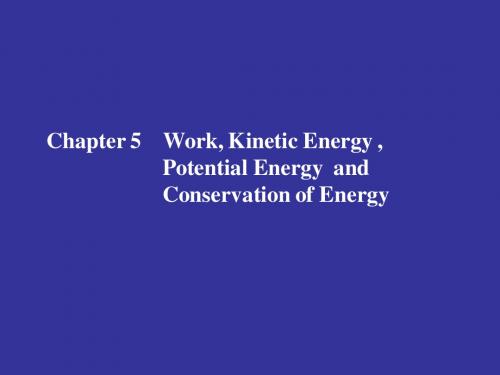
b aL
F1 dr
F2 dr
b aL
Fn dr W1 W2 Wn
a. Find the vector sum of the forces and integrate it over the displacement, or b. Find the work done by each individual force and add them.
Chapter 5 Work, Kinetic Energy , Potential Energy and Conservation of Energy
Main Points of Chapter 5
• Kinetic energy and the work-energy theorem • Conservative and nonconservative forces • Potential energy
(b), (a), (c), (d)
Work done by variable force in 3-D
• Work dWF of a force F acting
z
a M
F θ
r
through an infinitesimal displacementdr is:
dWF F dr
Scalar product
Work done by a constant force F
W F r • Only the component of F along the displacement is doing work. The force component perpendicular to the displacement does zero work
大学物理:第五章 流体力学 (Fluid Mechanics)
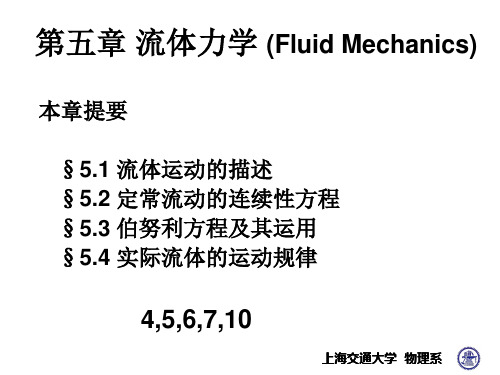
Aneurysm(动脉瘤)
若处动脉的半径增大N倍 血液流速就缩小N2倍 病灶处的压强大幅度上降 由于该处血管壁薄,使血 管容易破裂。
上海交通大学 物理系
Atherosclerosis(动脉粥样硬化)
动脉病变从内膜开始。一 般先有脂质和复合糖类积 聚、出血及血栓形成,纤 维组织增生及钙质沉着, 并有动脉中层的逐渐蜕变 和钙化,病变常累及弹性 及大中等肌性动脉,
?
? hB=0.5m
P0
?
0
1 2
v
2 c
ghc
Pc
1 2
v
2 A
ghA
PA
vc 2ghA 6 m / s
B,C点
1 2
v
2 c
ghc
Pc
1 2
v
2 B
ghB
PB
SBvB SCvC
PB P0 0.85g
PB P0 ghD
hD 0.85m
上海交通大学 物理系
一柱形容器,高1m、截面积为5x10-2 m2,储满水 ,在容器底部有一面积为2x10-4 m2 的水龙头,问 使容器中的水流尽需多少时间?
度变小,压强变大
压力
上海交通大学 物理系
马格纳斯效应
上海交通大学 物理系
机翼受到的举力
Q:用机翼上、下的流速变化,讨论其受到的升力,是否合理
上海交通大学 物理系
上海交通大学 物理系
压强的范围
太阳中心 地球中心 实验室能维持的最大压强 最深的海沟 尖鞋跟对地板 汽车轮胎 海平面的大气压 正常的血压 最好的实验室真空
四、液流连续原理(Principle of continuity of flow)
大学物理 库仑定律
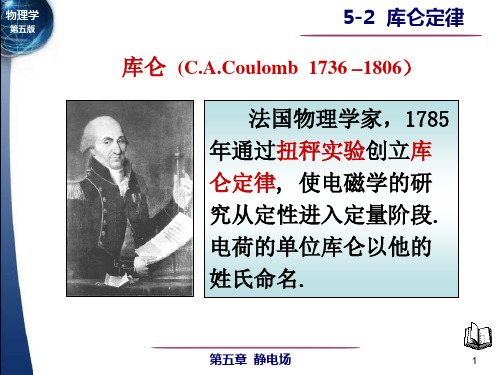
Fe/Fg
解:
。
Fe
1 4 0
e2 r2
Fg
G
memp r2
e 1.6 1019 C me 9.11031kg mp 1.67 1027kg
G=6.67×10-11N·m2·kg-2 所以: Fe=8.1×10-8 N
Fg=3.7×10-47N
Fe 2.3 1039 引力太小.
Fg第五章 静电场
4
物理学
第五版
选择进入下一节:
本章目录
5-1 电荷量子化 电荷守恒定律 5-2 库仑定律 5-3 电场强度 5-4 电场强度通量 高斯定理
*5-5 密立根测定电子电荷的实验
5-6 静电场的环路定理 电势能
第五章 静电场
5
r
q2第五章 静电场3物理学第五版 静电力与万有引力的比较
5-2 库仑定律
相同点:
不同点: 1.是两类性质的力;
1.都是“点模型”成立; 2.静电力有引力斥力之分;
2.都是平方反比;
3.静电力可以屏蔽;
3.都是保守力.
4.两者强度相差甚远.
例1:在氢原子中,电子与质子的距离为5.3×10-11m,求
1 4πε0
q1q2 r2
er
ε0 8.85 10 12 C2 N1 m2为真空电容率
q1 er
r
q2
第五章 静电场
2
物理学
第五版
5-2 库仑定律
F
1 4πε0
q1q2 r2
er
大小: F
1 4πε0
q1q2 r2
方向: q1和 q2同号相斥,异号相吸.
q1 er
2010大学物理学——5.刚体的转动

c a b
(2) 刚体的定轴转动
刚体上各点都绕同一转轴作不同半径 圆周运动, 的 圆周运动 , 且在相同时间内转过相 同的角度(角速度相同 角速度相同)。 同的角度 角速度相同 。
at v an
o
θ
v vv
s
S = Rθ v = Rω at = Rα 2 an = Rω
R
dθ ω = dt 2 α = dω = d θ 2 dt dt
= 6bt −12ct
2
Note:
角速度的矢量表示法: 角速度的矢量表示法:
ω
v
大小: 大小:ω 方向: 转轴 转轴, 方向://转轴 符合右手螺旋
ω
r⊥
v
v v
v v v 线速度: 线速度:v = ω × r
验证: 验证:
v r O
v v ω×r
大小: 大小: r⊥ ω 方向: 方向: 圆周切向
§5.5 转动中的功和能 (Rotational Work and Energy) 1.力矩的功 力矩的功
v F ⊥
F⊥t
ω
对于θ →θ +dθ,有
例5-8 已知:圆盘转动惯量J,初角速度ω0 已知:圆盘转动惯量 , 阻力矩M=-kω (k为正的常量 为正的常量) 阻力矩 为正的常量 所需的时间. 求:角速度从ω0变为ω0/2所需的时间 所需的时间 dω 转动定律: 解:转动定律: − kω = J dt t ω0 / 2 dω k → ∫ − dt = ∫ 0 ω0 J ω k ω /2 J ln 2 →− t = (ln ω) ω →t = J k [思考 思考] 思考
2
dm ∫
2
O
R
= mR
- 1、下载文档前请自行甄别文档内容的完整性,平台不提供额外的编辑、内容补充、找答案等附加服务。
- 2、"仅部分预览"的文档,不可在线预览部分如存在完整性等问题,可反馈申请退款(可完整预览的文档不适用该条件!)。
- 3、如文档侵犯您的权益,请联系客服反馈,我们会尽快为您处理(人工客服工作时间:9:00-18:30)。
Example 5-2 Show that the rotational inertia of a uniform annular cylinder (or ring) of inner radius R1, outer radius R2, and mass M, is I 1 M( R12 R22 ) , 2 as stated in Table 5-1b, if the rotation axis is through the center along the axis of symmetry. Divide the cylinder into thin concentric Solution: cylindrical rings or hoops of thickness dr, each with mass R1 r dm dV dr is the mass density of the body. or
1 2 2 1 1 1 2 2 2 2
2 i i
o
ri
mi
vi
mi is the mass of the ith particle and vi is its speed.
K 1 mi vi2 1 ( mi ri2 ) 2 2 2
rotational inertia (or moment of inertia) I Kinetic Energy of Rotation
z
Rotation axis
y Body Reference line y
r s
O
Rotation axis
x
O
x
Zero angular position
1. Angular Position A reference line fixed in the body, perpendicular to the rotation axis, and rotating with the body. The angular position of reference line describes the angular position of the body:
avg 2 Hale Waihona Puke 1t 2 t1 t
The (instantaneous) angular acceleration ,, is the limit in this equation as t approaches zero.
d lim t 0 t dt
The Position s=r
y
The Speed Differentiating the equation with respect to time—with r held constant
ds d r dt dt
r s
O
Rotation axis
x
v r
Zero angular position
The unit of angular acceleration is commonly the radian per second-squared (rad/s2) or the revolution per second-squared (rev/s2).
Are Angular Quantities Vectors?
(radian measure)
Equation of motion for a rotating body: = (t)
2. Angular Displacement When the body rotates about the rotation axis from 1 to 2, the body undergoes an angular displacement y 2 1 Reference At t2 line An angular displacement in the counterclockwise direction is positive, in the clockwise direction is negative. At t1 1 2 x 3. Angular Velocity O Rotation axis Average angular velocity The angular velocity is either 2 1 avg positive or negative, depending t2 t1 t on whether the body is rotating Angular velocity counterclockwise (positive) or d lim clockwise (negative). t 0 t dt
Linear mass density Surface mass density Volume mass density
Rotational inertia depends on following factors: Mass and shape of rigid body , position of rotation axis
Chapter 5 Rotations of Rigid Bodies
5-1 The Kinematics of Rotations about a Fixed Axis 5-2 Kinetic Energy of Rotation 5-3 Calculating the Rotational Inertia 5-4 Torque 5-5 Newton’s Second Law for Rotation 5-6 Work and Rotational Kinetic Energy 5-7 Angular Momentum 5-8 Newton’s Second Law in Angular Form 5-9 Conservation of Angular Momentum 5-10 The Spinning Top
= 0 +t
at r
0
t
r
2.56 0 (15) 0.38 m / s 2 0.039g 100
Although the final radial acceleration ar = 10g is large (and alarming), the astronaut’s tangential acceleration at during the speed-up is not.
at = r = 0 Therefore a = ar = 2 r = 10g
ar (10)(9.8) 2.56 rad / s 24 rev / s r 15
(Answer)
(b) What is the tangential acceleration of the astronaut if the centrifuge accelerates at a constant rate from rest to the angular speeds of (a) in 100 s? Solution: Because the angular acceleration is constant Then
5-1 The Kinematics of Rotations about a Fixed Axis A rigid body is a body that can rotate with all its parts locked together and without any change in its shape. A fixed axis means that the rotation occurs about an axis that does not move. z In the description of the rotational Rotation Body motion, we shall introduce angular axis equivalents of the linear quantities position, displacement, velocity, r P and acceleration. y These quantities not only describe x O the rigid body as a whole but also for every particle within that body.
0
0 0 t t
1 2
2
x x0 v0t 1 at 2 2
2 v 2 v0 2a( x x0 )
2 2 0 2 ( 0 )
avg
0
2
vavg
v v0 2
Relating with Linear and Angular Variables
z Axis z
Axis
Right-hand rule z Axis Speeding up Axis Slowing down z
5. Rotation with Constant Angular Acceleration In pure translation, motion with a constant linear acceleration is an important special case. In pure rotation, the case of constant angular acceleration is also important, and a parallel set of equations holds for this case also. Angular Linear 0 t v v at
Checkpoint 1 The Acceleration Differentiating the equation with respect to time—again with r held constant dv d v2 2
